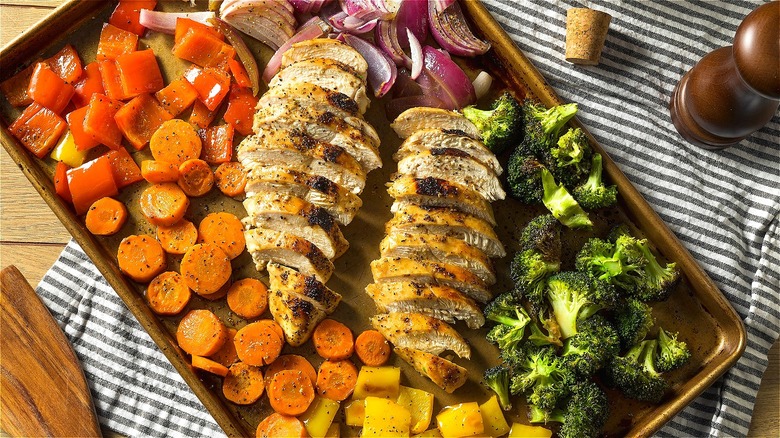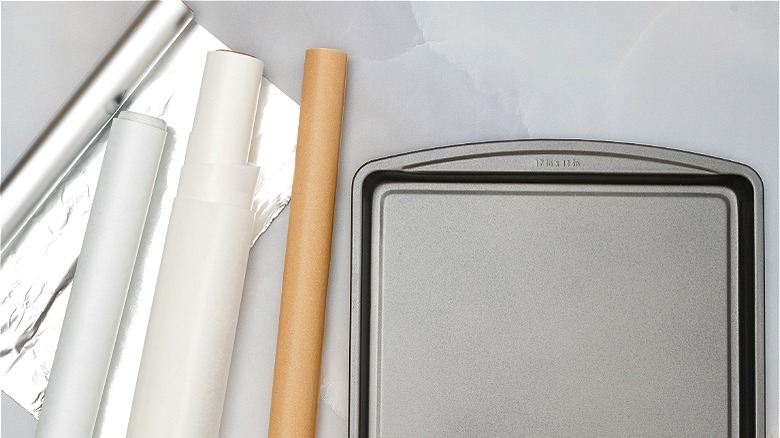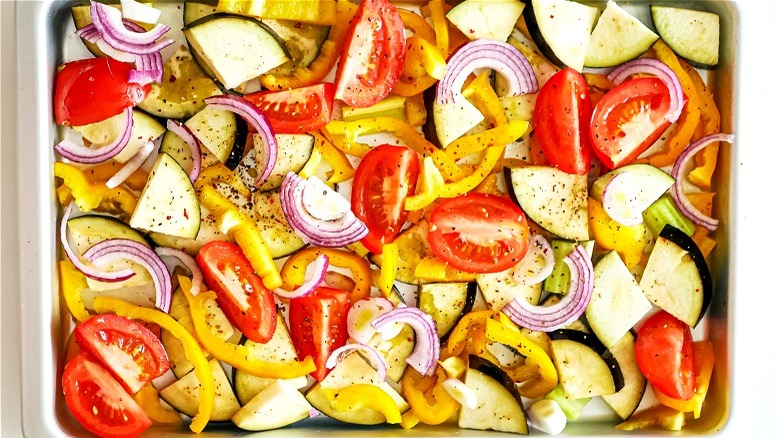Why 1-Sheet Pan Meals Are Superior To 1-Pot Meals For Lazy Dinners
Picture yourself on a late weekday evening attempting to piece together leftover protein, vegetables, and a cooked grain or two that's been tucked away in your refrigerator. Sure, if you planned ahead and secured all the ingredients to make 1-pot chicken and rice, you'd be set; but dumping a mish-mash of the week's unused food into a pot doesn't necessarily make sense unless you're following a specific recipe. The ingredients for meals made in just one pot tend to be working together to create the same flavor profile. You can't necessarily make curry carrots and roasted fingerling potatoes in addition to a mildly seasoned chicken breast with only your trusted Dutch oven.
If you're feeling lazy yet still long for distinct flavors and textures in your weeknight meals, instead turn to your trusted sheet pans for dinner success. Using sheet pans, you can create various flavor profiles for each individual ingredient with minimal effort and even alter the cooking time of your foods based on the ingredients you have on hand. Basically, you can tailor-make an entire meal by using one or two sheet pans to separate, for example, your chicken from your broccoli to give each food its own distinct taste.
But, before showcasing the diversification of sheet pan meals, what else makes one-sheet pan dishes the go-to option for when you want a delicious meal without having to work too hard?
Sheet pan meals provide texture and are easy to clean up
There's just something about roasted food that stands tall against ingredients cooked together in one pot. With one-pot meals, all of your ingredients are often simmered together to create a concentrated flavor across the board. There isn't too much texture variance in one-pot meals either. Sure, with dishes like one-pot Tex-Mex pasta, you add a few counteracting fresh ingredients before serving; however, sheet pan meals have the ability to carmelize and develop complexity due to browning. Browning (or the Maillard reaction) occurs around 300 degrees Fahrenheit when foods begin to change color and develop in flavor. Then comes caramelization at 320 degrees which can actually develop the natural sugars hidden within your favorite vegetables.
This flavorful reaction, coupled with the fact that sheet pan meals are fairly easy to clean up after, makes them a winner, especially for those nights you don't feel like putting forth a great deal of effort. You can even line your sheet pans with parchment paper so that when dinner is over, all you need to do is throw away the used paper and give your pans a quick wash. Alternatively, with one-pot meals, you'll have to scrub out that Dutch oven or stockpot when all is said and done.
Now that you know the benefits of sheet pan meals, how do you make one without a specific meal plan?
How to make delicious sheet pan meals
Sure enough, sheet pans have the ability to do the bulk of the work for you. You can create many one-pan dishes by simply dividing up your current food assortment and varying the cook times of each ingredient. How simple is that? If you don't have time to sift through all of the sheet pan dinner recipes that will make your life easier, you can still put forth a small amount of effort and be pleasantly surprised by the meals you create by following a few simple steps.
If vegetables are sure to be a main component of your one-pan meals, make sure all varieties are evenly cut and cooked based on their general structure. Sturdier veggies like sweet potatoes can take up to thirty minutes in a 400-degree oven, while loose greens like kale and spinach have shorter cook times, taking as little as 3 minutes to roast.
You also want to make sure to use enough fat in addition to your favorite spices. Coat your protein and vegetables of choice lightly and evenly in the oil or fat of your choice to secure browning and caramelization.
Whichever ingredients you have on hand, the beauty of sheet pan meals lies in your ability to tap into your own culinary creativity without meticulously following a recipe and leaving you tied to your stove for hours. While one-pot meals have a designated place in all of our recipe books, one-pan meals require little effort and can embody varying degrees of both flavor and texture.


